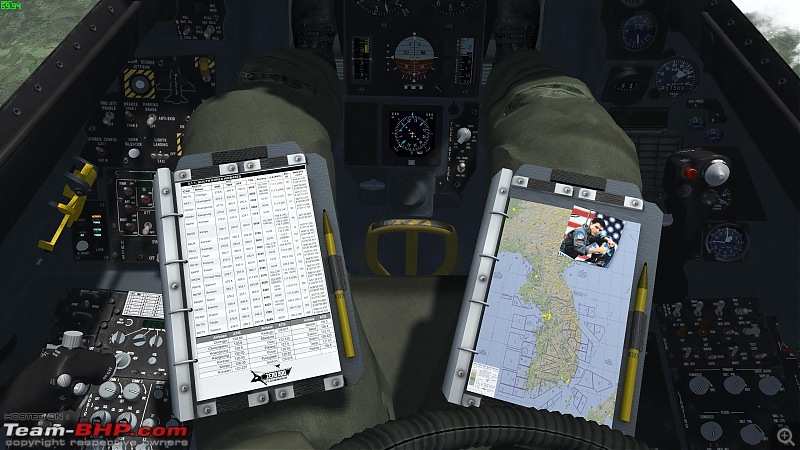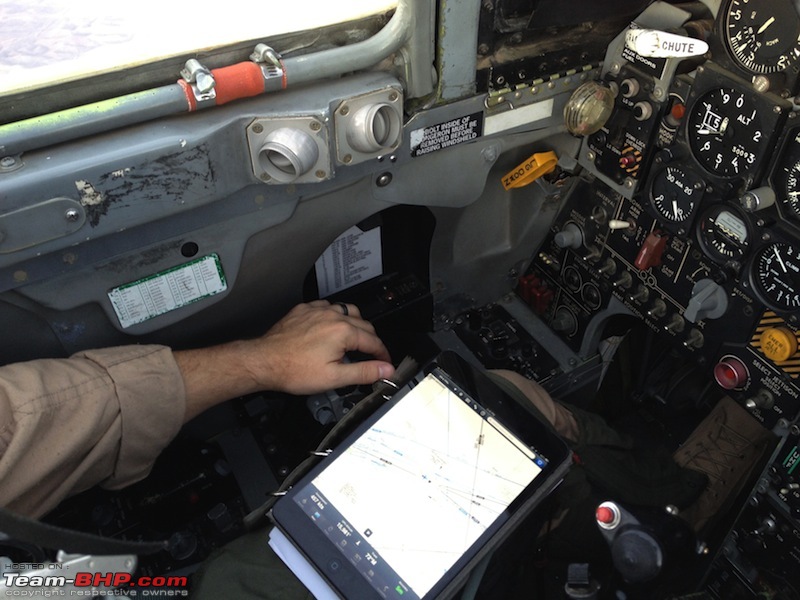Team-BHP
(
https://www.team-bhp.com/forum/)
Quote:
Originally Posted by SmartCat
(Post 4651592)
Any idea why Abhinandan's flight suit looks so different? In actual combat, are those pockets for carrying maps, identification documents etc?
|
Those kneeboards, while sitting in the cockpit, would look something like this to the pilot (from the flight sim Falcon 4.0):



How it actually looks:

They usually contain documents that can be used as a Quick Reference guide/Manual, mission briefing/profile to be flown, Maps, Radio frequencies etc. I have seen fighter pilots using Ipads also.

Also, if you look closely enough at his flight suit, you can make out his squadron patch. It is a Bison squadron for sure and pilots from that squadron were the first to shoot down PAF fighters in the 1965 war!!!!
Quote:
Originally Posted by skanchan95
(Post 4651588)
Pics of the first IAF Rafale RB001, a twin seat variant, in full IAF markings
|
Have the deliveries commenced already? What is the expected schedule?
Quote:
Originally Posted by skanchan95
(Post 4651588)
Pics of the first IAF Rafale RB001, a twin seat variant, in full IAF markings..
|
Looking sweet. Glad to see them coming in at a trickle at last. Any idea what the split is for the initial order in terms of twin seat and single seat variants? Or are they all twin seat variants (always get the feeling the IAF leans towards two in the cockpit).
Going by rule of thumb I'd imagine you'd have a third of those, 12, as twin seat variants mostly used for training with a third on combat rotation.
Quote:
Originally Posted by Gansan
(Post 4651694)
Have the deliveries commenced already? What is the expected schedule?
|
I think the first IAF Rafale will be "accepted" this month in a ceremony in France. The Air Chief and the DM are going to attend the ceremony. However, this does not mean that the Rafales will fly to India straightaway. The first four Rafales will come to India only in April next year, with the last of the 36 Rafales slated to be delivered in 2022.
Quote:
Originally Posted by ads11
(Post 4651911)
Looking sweet. Glad to see them coming in at a trickle at last. Any idea what the split is for the initial order in terms of twin seat and single seat variants? Or are they all twin seat variants (always get the feeling the IAF leans towards two in the cockpit).
|
The 36 Rafale order for the IAF had been split into 28 single seat (Rafale EH) and eight dual seat (Rafale DH).
Quote:
Originally Posted by skanchan95
(Post 4651943)
I think the first IAF Rafale will be "accepted" this month in a ceremony in France. The Air Chief and the DM are going to attend the ceremony. However, this does not mean that the Rafales will fly to India straightaway. The first four Rafales will come to India only in April next year, with the last of the 36 Rafales slated to be delivered in 2022.
The 36 Rafale order for the IAF had been split into 28 single seat (Rafale EH) and eight dual seat (Rafale DH).
|
Ah cool, I wasn't too far off in my estimate! Where do I sign up to be a defence mandarin right now? I think this qualifies me for the procurement job given past evidence!
Jokes aside, I imagine the first 4 Rafales will probably spend their formative time seconded with a squadron in France. Similarly IAF aviators who'll end up instructing the rest of the fleet will end up there too till April. Hopefully another 36 unit order is made (my secret hope is that in tiny piece meal increments, the IAF and IN realise that having a common platform is the smart thing to do and we end up with enough Rafales to make sense..ever the wishful thinker that I am)
Quote:
Originally Posted by Deepsp
(Post 4652168)
HAL shared a video of their LUH
|
In my business we operated a Dhruv for a civilian agency on a very demanding requirement which needed nap-of-the-earth flying for 3 hours each day for a year. The helicopter, I must say, performed flawlessly on what was very demanding & high risk precision flying. It is basically a sound machine.
Here's an image of Ardiden 1U engine, manufactured by Safran Helicopter Engines, France. This engine is powering HAL LUH helicopters.
Quote:
Originally Posted by V.Narayan
(Post 4652548)
In my business we operated a Dhruv for a civilian agency on a very demanding requirement which needed nap-of-the-earth flying for 3 hours each day for a year. The helicopter, I must say, performed flawlessly on what was very demanding & high risk precision flying. It is basically a sound machine.
|
Sir, what do you mean by nap-of-the- earth flying? Is this an aviation term?
Quote:
Originally Posted by Shreyans_Jain
(Post 4653076)
Sir, what do you mean by nap-of-the- earth flying? Is this an aviation term?
|
This term means you fly very low at a fixed height above the ground and go up and down exactly following the contours of the Earth's surface below you. Typically this sort of flying would be between 40 to 100 metres altitude. So as you approach a hill you fly above it following the slope but keeping your man altitude above the slope the same. I hope this helps.
Quote:
Originally Posted by V.Narayan
(Post 4653093)
This term means you fly very low at a fixed height above the ground and go up and down exactly following the contours of the Earth's surface below you. Typically this sort of flying would be between 40 to 100 metres altitude. So as you approach a hill you fly above it following the slope but keeping your man altitude above the slope the same. I hope this helps.
|
Just to be clear a military chopper could do this flying 10 metres or less off the ground depending on terrain and speed. A fast combat jet would usually stay north of 30 to 50 metres due to power pylons and his much higher speed. In a helicopter sometimes you go over the cone of the peak of a hill and at other times you fly along the side most often titlted but staying the same mean distance from the ground.
Quote:
Originally Posted by Shreyans_Jain
(Post 4653076)
Sir, what do you mean by nap-of-the- earth flying? Is this an aviation term?
|
Nap of the Earth(NOE) is a term used for very low level flight. Such NOE profiles are flown by military aircraft to avoid detection and attack by the bad guys.
As the aircraft is flown at very low level, flawless attention to task is required by the pilot(s). The pilots use terrain features like hills, valleys, trees, bends, fly over unhabited areas,between gaps in radar coverage to mask their aircraft and avoid detection.
Aircraft that are flown at high altitudes are easy to detect by ground based radars, patrolling enemy fighters and AWACS, which gives enough time to the enemy to react.Using NOE approach to a target, a well planned approach usually remains undetected, he aircraft "pops up" to attack the target and then turns to escape before the enemy defences get alerted and can respond. Although it is relatively easy for helicopters to perform NOE flights because of their slower flying speeds, fighter and transport aircraft equipped with Terrain Following Radars(TFR) makes NOE flights easier for them as well.
The TFR works by transmitting a radar signal towards the area in front of the aircraft. The radar returns is then be analysed by the onboard computers to see how the terrain ahead varies, which can then be used by the aircraft's autopilot to maintain a reasonably constant height above the earth.
Basically how a TFR works on a fighter for NOE flights:
https://www.youtube.com/watch?v=XeM4SpRb-ZA
This is what a NOE flight would look like from a helicopter cockpit (UH-60 from Armed Assault 3):
https://www.youtube.com/watch?v=iH2DhpfT-1A
Quote:
Originally Posted by V.Narayan
(Post 4653131)
Just to be clear a military chopper could do this flying 10 metres or less off the ground depending on terrain and speed. A fast combat jet would usually stay north of 30 to 50 metres due to power pylons and his much higher speed. In a helicopter sometimes you go over the cone of the peak of a hill and at other times you fly along the side most often titlted but staying the same mean distance from the ground.
|
HT pylons are even more of a problem for helicopters because these are flown lower for NOE flight. I believe the helicopter pilots are taught to go over the pylons and not try their luck in the space between two pylons. No matter what the visibility. Even more important in a nighttime military mission.
Regards
Sutripta
| All times are GMT +5.5. The time now is 16:24. | |






